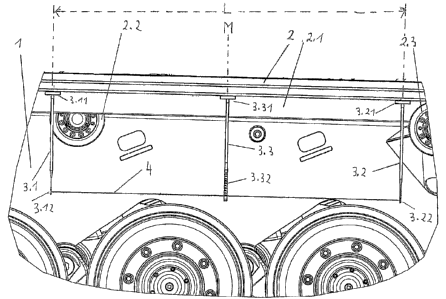Une partie des informations de ce site Web a été fournie par des sources externes. Le gouvernement du Canada n'assume aucune responsabilité concernant la précision, l'actualité ou la fiabilité des informations fournies par les sources externes. Les utilisateurs qui désirent employer cette information devraient consulter directement la source des informations. Le contenu fourni par les sources externes n'est pas assujetti aux exigences sur les langues officielles, la protection des renseignements personnels et l'accessibilité.
L'apparition de différences dans le texte et l'image des Revendications et de l'Abrégé dépend du moment auquel le document est publié. Les textes des Revendications et de l'Abrégé sont affichés :
| (12) Brevet: | (11) CA 2636530 |
|---|---|
| (54) Titre français: | PROCEDE DE MESURE DE LA FLECHE DE CHAINE SUR UN VEHICULE CHENILLE |
| (54) Titre anglais: | METHOD FOR MEASURING THE SLACK OF CHAIN ON A TRACKED VEHICLE |
| Statut: | Réputé périmé |
| (51) Classification internationale des brevets (CIB): |
|
|---|---|
| (72) Inventeurs : |
|
| (73) Titulaires : |
|
| (71) Demandeurs : |
|
| (74) Agent: | SMART & BIGGAR IP AGENCY CO. |
| (74) Co-agent: | |
| (45) Délivré: | 2011-09-20 |
| (86) Date de dépôt PCT: | 2007-10-20 |
| (87) Mise à la disponibilité du public: | 2008-05-02 |
| Requête d'examen: | 2009-08-07 |
| Licence disponible: | S.O. |
| (25) Langue des documents déposés: | Anglais |
| Traité de coopération en matière de brevets (PCT): | Oui |
|---|---|
| (86) Numéro de la demande PCT: | PCT/DE2007/001874 |
| (87) Numéro de publication internationale PCT: | WO2008/049396 |
| (85) Entrée nationale: | 2008-07-04 |
| (30) Données de priorité de la demande: | ||||||
|---|---|---|---|---|---|---|
|
La présente invention concerne un procédé de mesure de la flèche de chaîne sur un véhicule chenillé. Trois éléments prolongateurs (3.1, 3.2, 3.3) s'étendant verticalement vers le bas depuis le brin supérieur (2) de longueur prédéfinie sont fixés sur le brin supérieur (2) de la chaîne, de telle sorte qu'un premier et un deuxième élément prolongateur (3.1, 3.2) soient disposés chacun au point d'origine et au point final d'une section longitudinale (L) prédéfinie du brin supérieur (2), tandis qu'un troisième élément prolongateur (3.3) est disposé au milieu (M) de la section longitudinale (L) prédéfinie. Les extrémités d'un fil (4) sont fixées au premier et au deuxième élément prolongateur (3.1, 3.2), à une hauteur prédéfinie au-dessous du brin supérieur (2) de la chaîne, de sorte que celui-ci est tendu dans le sens horizontal entre le premier et le deuxième élément prolongateur (3.1, 3.2). Le troisième élément prolongateur (3.3) portant une échelle de mesure (3.32) permet de déterminer la distance verticale entre le milieu de la section longitudinale (L) du brin supérieur (2) de la chaîne et le milieu du fil (4). Les éléments prolongateurs (3.1, 3.2, 3.3) peuvent être conçus sous forme de barres qui portent à une extrémité une plaque de fixation (3.11, 3.21, 3.31) conçue sous forme d'aimant permanent.
A method for measuring the slack of chain on a tracked
vehicle. On the upper strand (2) of the chain, three extension
elements (3.1, 3.2, 3.3) of predetermined length are fixed
running vertically from the upper strand downwards in such a way
that a first and a second extension element (3.1, 3.2) are
arranged, one at the starting point and the other at the end
point, of a predetermined segment (L) of the upper strand (2),
while a third extension element (3.3) is arranged at the middle
(M) of the predetermined segment (L). On the first and second
extension elements (3.1, 3.2), the ends of a cord (4) are
fastened at a predetermined height below the upper strand (2) of
the chain in such a way that said cord is stretched horizontally
between the first and second extension elements (3.1, 3.2). By
means of the third extension element (3.3), which carries a
measuring scale (3.32), the vertical distance from the middle of
the segment (L) of the upper strand (2) of the chain to the
middle of the cord (4) is determined. The extension elements
(3.1, 3.2, 3.3) can be shaped like rods which carry on one end
thereof a fastening plate (3.11, 3.21, 3.31) formed as a
permanent magnet.
Note : Les revendications sont présentées dans la langue officielle dans laquelle elles ont été soumises.
Note : Les descriptions sont présentées dans la langue officielle dans laquelle elles ont été soumises.

Pour une meilleure compréhension de l'état de la demande ou brevet qui figure sur cette page, la rubrique Mise en garde , et les descriptions de Brevet , États administratifs , Taxes périodiques et Historique des paiements devraient être consultées.
| Titre | Date |
|---|---|
| Date de délivrance prévu | 2011-09-20 |
| (86) Date de dépôt PCT | 2007-10-20 |
| (87) Date de publication PCT | 2008-05-02 |
| (85) Entrée nationale | 2008-07-04 |
| Requête d'examen | 2009-08-07 |
| (45) Délivré | 2011-09-20 |
| Réputé périmé | 2020-10-20 |
Il n'y a pas d'historique d'abandonnement
Les titulaires actuels et antérieures au dossier sont affichés en ordre alphabétique.
| Titulaires actuels au dossier |
|---|
| KRAUSS-MAFFEI WEGMANN GMBH & CO. KG |
| Titulaires antérieures au dossier |
|---|
| WITTMANN, CHRISTOPH |